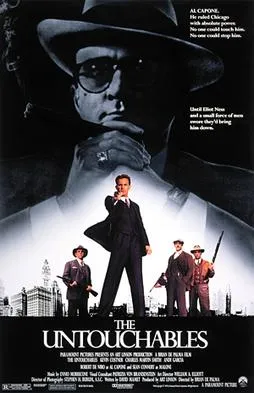Historical accuracy of The Untouchables

Historical accuracy of The Untouchables

Characters
Eliot Ness
Ness was the real agent leading the investigation against Capone. However, the film portrays him as more naive initially and far more involved in violent confrontations and the tax case than he was historically. His personality is dramatized.
Jim Malone
Malone is a completely fictional character created for the film, serving as Ness's mentor and providing experienced muscle. He has no direct historical counterpart in Ness's real team.
George Stone (G. Petri)
Stone is a fictional character, added to the team for his marksmanship skills and to explore themes of ethnicity and loyalty.
Oscar Wallace
Wallace is a fictional character representing the financial investigation angle. The crucial tax investigation was primarily conducted by IRS agents like Frank J. Wilson, not Ness's Prohibition unit members.
Al Capone
Capone was the real gangster target. De Niro's portrayal captures his public image, power, and capacity for violence (like the baseball bat incident, based on a real event but with different victims/context). Specific scenes are dramatized.
Frank Nitti
Nitti was a real, high-ranking member of Capone's organization. His portrayal as a primary enforcer is accurate, but his depicted actions (murders of Wallace/Malone) and dramatic death are fictional.
More characters
Walter Payne
A fictional character representing the financial insiders whose testimony was crucial for the tax case. The real key witnesses were different individuals secured by IRS agents.
Police Chief Mike Dorsett
A fictional character representing the widespread police corruption that Ness encountered in Chicago.
Catherine Ness
Evaline Ness was Eliot's real wife. Her portrayal as supportive but concerned is plausible, though her direct involvement or endangerment as shown is likely dramatized.
Ness's Daughter
Eliot Ness adopted a son much later in life. The young daughter depicted in the film's timeframe is fictional, added to heighten stakes and portray Ness's family life.
Baseball Bat Victim
Based on a real incident where Capone beat men to death (likely Albert Anselmi, John Scalise, and possibly Joseph Guinta) in 1929. The specific character name/context in the film differs.
Story
Setting: Prohibition-era Chicago, Ness vs. Capone
The film accurately depicts the backdrop of Prohibition in Chicago (c. 1930-31) and the historical conflict between federal agent Eliot Ness and gangster Al Capone.
Widespread corruption hindering Ness
Ness did face significant challenges due to pervasive corruption within the Chicago police force, judiciary, and city politics, which protected Capone's operations.
Ness forming small team of "Untouchables"
Ness did assemble a small, trusted team known for their incorruptibility (True). However, the iconic members depicted (Malone, Stone, Wallace) are fictional creations, not the real historical agents (False).
Raids on Capone's breweries/smuggling
Ness's team did conduct numerous successful raids on Capone's illegal alcohol operations, significantly disrupting his business, as depicted.
Canadian border liquor seizure / shootout
The dramatic horseback raid and shootout at the Canadian border is entirely fictional, though liquor smuggling from Canada was common during Prohibition.
Capone ordering violence against Ness's team
Capone's organization did use violence and intimidation, and Ness did face threats. However, the specific murders of Wallace and Malone as depicted are fictional.
Murders of Wallace (elevator) and Malone (home)
These characters are fictional, and their dramatic murders orchestrated by Nitti did not happen.
Union Station shootout (baby carriage scene)
This iconic, stylized sequence inspired by Eisenstein's Battleship Potemkin is completely fictional and did not occur.
Focus shifting to tax evasion case
While Ness's raids hurt Capone, the crucial legal breakthrough came from investigating Capone for income tax evasion.
Ness's role in the tax case
Ness's Prohibition unit provided some support, but the primary investigation and case-building for tax evasion were done by IRS agents (Frank Wilson, Elmer Irey), whose roles are largely given to fictional Wallace.
Securing bookkeeper testimony (Payne)
Obtaining insider financial testimony was key to the tax case (True). The character Walter Payne and the specific circumstances of his cooperation/protection are fictional (False).
Jury tampering during Capone's trial
There were real concerns about jury tampering in Capone's trial, leading Judge Wilkerson to famously switch the jury pool at the last minute. Ness's direct confrontation with the judge is likely fictional.
Frank Nitti's death (pushed off roof by Ness)
Nitti died by suicide in 1943, years after Capone's conviction, and was not killed by Eliot Ness.
Capone convicted for tax evasion
Al Capone was convicted on several counts of income tax evasion in 1931 and sentenced to prison.
Setting
Chicago, c. 1930-1931 (Prohibition Era)
The film is accurately set in Chicago during the height of Capone's power and the enforcement efforts of Prohibition.
Architecture (Union Station, Lexington Hotel, Courthouse)
The film utilizes real Chicago locations or convincing recreations, capturing the architectural style of the period, including famous spots associated with the era like Union Station.
Fashion and Style (suits, hats, dresses)
Costumes accurately reflect the typical men's and women's fashion of the early 1930s in urban America.
Automobiles and Technology
Vehicles, firearms (especially the Thompson submachine gun), telephones, and other technology appear authentic to the period.
Atmosphere of Crime, Corruption, and Speakeasies
Effectively portrays the atmosphere of Prohibition-era Chicago: rampant organized crime, widespread political and police corruption, illegal speakeasies, and sudden bursts of gang violence.
Prohibition Raids
Scenes depicting raids on illegal breweries and warehouses visually represent the activities of Prohibition enforcement agents like Ness's team.
Courtroom setting
The depiction of the courtroom during Capone's trial reflects the typical appearance and procedures of a federal court in that era.
US-Canada Border setting (as depicted)
While the specific location/action is fictional, the setting represents the smuggling routes used during Prohibition, though perhaps stylized.
Visual tone of the era
The film's cinematography and production design successfully evoke the visual feel and mood of 1930s urban America, particularly its darker, crime-ridden aspects.
